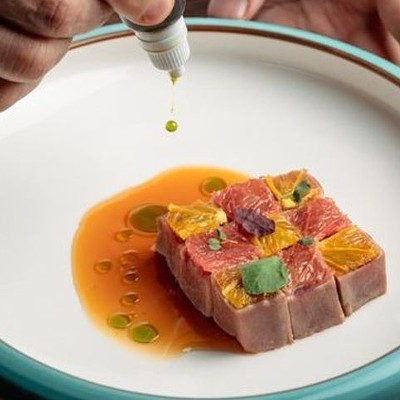A post earlier this week ("Wine of the Week: A Wine with No Detectable Sulfites") inspired a lot of acidic (pun intended) discussion here at Eating Our Words and around the enoblogosphere.
The question of sulfites in wine, their effect on the aroma and flavor of the wine, and their potential impact on health is one of the thorniest issues in the world of wine today -- especially when it comes to the categories of organic, biodynamic, and Natural wine.
Let's start a healthy discussion (pun intended) by debunking some of the common myths associated with sulfites in wine.
1) There is no wine that does not contain sulfites. Even when no sulfur dioxide (SO2) has been added to wine, it will still contain sulfites. Sulfur is one of the natural byproducts (sulfur metabolism) of fermentation (whereby yeast turns sugar into alcohol).
2) Red wine does not contain more sulfites than white wines. Actually, the opposite is true: Because SO2 is used to prevent oxidation of wine and subsequent "browning" of white wine, commercial producers use more SO2 for their white wines.
3) Sulfured (sulfurated) wines are an industry standard and the use of sulfur is widely embraced by every category in the world of wine today. According to the Oxford Companion to Wine, only "a fraction of 1 percent" of winemakers in the world today make wine without the use of S02. Opus One (Napa Valley)? Domaine de la Romanée-Conti (Burgundy)? Yellowtail (Australia)? Yes, they all use SO2.
4) The "sulfite headache" is a myth. Although some people are extremely sensitive to sulfites (according to the FDA about 0.4 percent of Americans are allergic to sulfites), the headache you can experience after drinking wine is more likely due to the high alcohol content of a given wine and to the way the wine is applied (in other words, if you drink a bottle of 17 percent alcohol Pinot Noir from the Central Coast of California without food, you are going to get a headache due to the subsequent dehydration).
5) Despite our knee-jerk reaction to the thought of SO2 being added to wine, its use in winemaking is -- without a doubt -- a good thing. In the nineteenth century (not that long ago, when you consider that wine has been produced by humankind since antiquity), a greater understanding of microbiology revolutionized the fine wine industry. Keep in mind: Before Pasteur (1822-1895), no one understood how microorganisms affect wine and the way it smells and tastes. The application of sulfites today is part of Pasteur's legacy.
So why does the U.S. Alcohol and Tobacco Tax and Trade Bureau require that winemakers write "contains sulfites" on the label? The requirement is owed to the fact that 5 percent of asthmatics can have a violent reaction to sulfites. Until the Common Market Organisation reforms of the 1990s, European Union winemakers were not required to write "contains sulfites" on the label.
So why and how do winemakers use sulfur in winemaking?
1) They use sulfur to clean winemaking vessels and other equipment.
2) They use sulfur to prevent oxidation in wines before, during, and after fermentation. (Because oxygen binds to SO2, it prevents oxygen from binding with other elements in the wine. Premature oxidation can cause a browning of white wine and it can cause unwanted aromas in wine, white and red.)
3) They use sulfur after fermentation to kill unwanted bacteria that could cause undesirable aromas and flavors.
Can the average taster detect SO2 in wine? Yes. If excessive amounts of SO2 have been used in winemaking, you can smell it. It smells like burnt matches.
Do some winemakers use more SO2 than others? Yes. High-volume commercial winemakers tend to use more SO2 because they need their wines to stabilize more quickly in order to ship the wine and create more space in the winery. The biggest offenders? Producers of large-volume, industrial white wine.
How much SO2 is allowed in wine? In the U.S., 350 parts per million. In Europe, 160 ppm for red wine; 210 ppm for white wine (again, the European numbers reflect a greater need for SO2 in the production).
Can fine wine be made without the use of SO2? Yes, definitely. Some of our favorite wines are "unsulfured" and there are many different techniques used to make wines without SO2. But they represent a tiny segment of the wine industry and the resulting wines often have "flaws" and variation that makes them difficult to market.
The bottom line? The wine industry, as we know it, would not exist today without the use of SO2 and we wouldn't have access to the great wines of the world (because they would be too delicate to ship).
Do wines with lower amounts of added sulfites taste better than wines with greater amounts? In my opinion, they do. In my view and experience, minimal use of sulfites (in other words, using the smallest amount possible) reflects the winemaker's will to make better, more honest, more wholesome, and more genuine wine. It takes more time and patience to make wine with lower amounts of added SO2 (and it costs more). But it makes for better wine.
My advice? Look for wines with natural acidity: The higher the natural acidity (and the lower the pH), the lower the amount of SO2 needed to stabilize the wine. If you've been following along here at Wine Time, you know that natural acidity is the key to the wines that Tracie P and I like and drink at home. Buttery Chardonnay from California? More SO2 needed. Dry Chenin Blanc from the Loire Valley, France? Less SO2 needed.
Please share your thoughts/experiences/suggestions on sulfites in wine in the comments section below.
Follow Eating Our Words on Facebook and on Twitter @EatingOurWords






